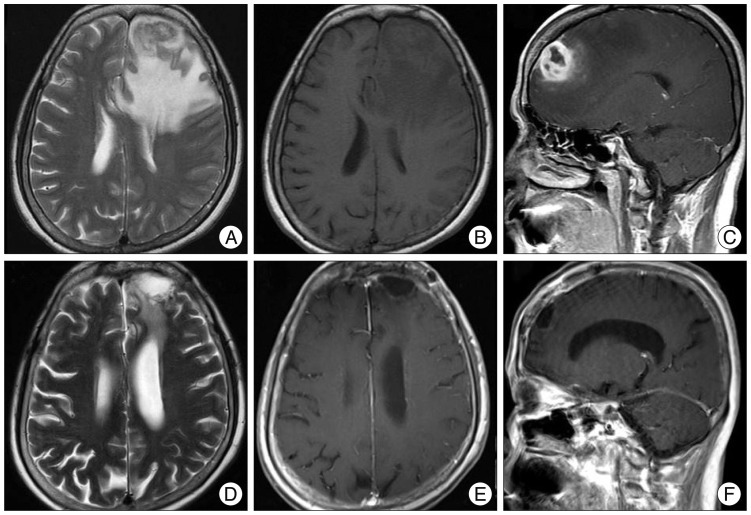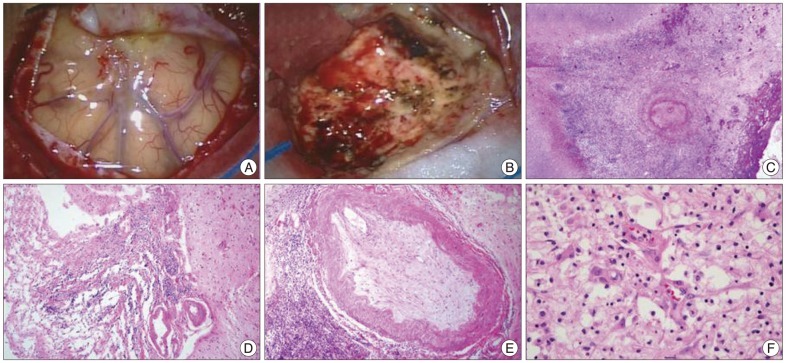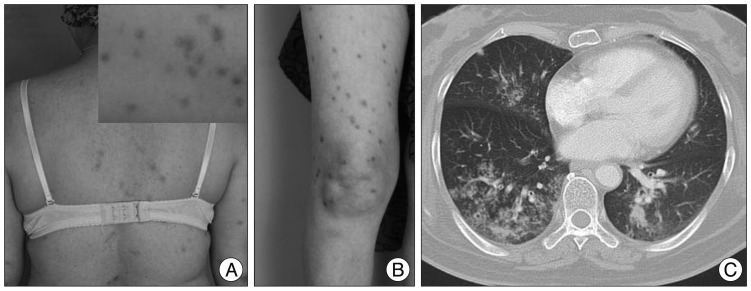J Korean Neurosurg Soc.
2013 Mar;53(3):197-200. 10.3340/jkns.2013.53.3.197.
Cerebral Syphilitic Gumma Mimicking a Brain Tumor in the Relapse of Secondary Syphilis in a Human Immunodeficiency Virus-Negative Patient
- Affiliations
-
- 1Division of Infectious Diseases, Department of Internal Medicine, Korea University College of Medicine, Seoul, Korea.
- 2Department of Pathology, Korea University College of Medicine, Seoul, Korea.
- 3Department of Neurosurgery, Korea University College of Medicine, Seoul, Korea. hermes23@kumc.or.kr
- KMID: 2190766
- DOI: http://doi.org/10.3340/jkns.2013.53.3.197
Abstract
- Diagnosis of cerebral syphilitic gumma is frequently determined at the time of surgery, because imaging and laboratory findings demonstrate the elusive results. A 59-year-old woman presenting dysarthria showed a mass on her brain computed tomography. She was first suspected of brain tumor, but histological results from surgical resection revealed cerebral gumma due to neurosyphilis. After operation, she presented fever and rash with an infiltration on a chest X-ray. Histological assessment of skin was consistent with syphilis. Fluorescent treponemal antibody absorbed test IgG in cerebrospinal fluid was positive. She was successfully treated with ceftriaxone for 14 days.
MeSH Terms
Figure
Cited by 2 articles
-
Re-emerging Neurosyphilis in Korea as a Possible Etiology of Psychotic Disorders with Pleomorphic Symptoms and Cognitive Dysfunction: a Case Report and Literature Review
Sang-Hun Lee, Hyunju Yang, Na Ri Kang, Joon Hyuk Park
J Korean Med Sci. 2020;35(33):e271. doi: 10.3346/jkms.2020.35.e271.Unusual Presentation of Secondary Syphilis in Korea: 2010-2014 Review
Dan Song, Jae Heon Kim
Korean J Urogenit Tract Infect Inflamm. 2015;10(1):19-24. doi: 10.14777/kjutii.2015.10.1.19.
Reference
-
1. Ances BM, Danish SF, Kolson DL, Judy KD, Liebeskind DS. Cerebral gumma mimicking glioblastoma multiforme. Neurocrit Care. 2005; 2:300–302. PMID: 16159080.
Article2. Berger JR, Waskin H, Pall L, Hensley G, Ihmedian I, Post MJ. Syphilitic cerebral gumma with HIV infection. Neurology. 1992; 42:1282–1287. PMID: 1620334.
Article3. Brightbill TC, Ihmeidan IH, Post MJ, Berger JR, Katz DA. Neurosyphilis in HIV-positive and HIV-negative patients : neuroimaging findings. AJNR Am J Neuroradiol. 1995; 16:703–711. PMID: 7611026.4. Clark EG, Danbolt N. The Oslo study of the natural history of untreated syphilis; an epidemiologic investigation based on a restudy of the Boeck-Bruusgaard material; a review and appraisal. J Chronic Dis. 1955; 2:311–344. PMID: 13252075.5. Cnossen WM, Niekus H, Nielsen O, Vegt M, Blansjaar BA. Ceftriaxone treatment of penicillin resistant neurosyphilis in alcoholic patients. J Neurol Neurosurg Psychiatry. 1995; 59:194–195. PMID: 7629543.
Article6. Coleman DL, McPhee SJ, Ross TF, Naughton JL. Secondary syphilis with pulmonary involvement. West J Med. 1983; 138:875–878. PMID: 6613117.7. Darwish BS, Fowler A, Ong M, Swaminothan A, Abraszko R. Intracranial syphilitic gumma resembling malignant brain tumour. J Clin Neurosci. 2008; 15:308–310. PMID: 18187326.
Article8. Fargen KM, Alvernia JE, Lin CS, Melgar M. Cerebral syphilitic gummata : a case presentation and analysis of 156 reported cases. Neurosurgery. 2009; 64:568–575. discussioin 575-576. PMID: 19240620.9. Gentile JH, Viviani C, Sparo MD, Arduino RC. Syphilitic meningomyelitis treated with ceftriaxone : case report. Clin Infect Dis. 1998; 26:528. PMID: 9502500.
Article10. Holland BA, Perrett LV, Mills CM. Meningovascular syphilis : CT and MR findings. Radiology. 1986; 158:439–442. PMID: 3941870.11. Horowitz HW, Valsamis MP, Wicher V, Abbruscato F, Larsen SA, Wormser GP, et al. Brief report : cerebral syphilitic gumma confirmed by the polymerase chain reaction in a man with human immunodeficiency virus infection. N Engl J Med. 1994; 331:1488–1491. PMID: 7969298.
Article12. Lee CW, Lim MJ, Son D, Lee JS, Cheong MH, Park IS, et al. A case of cerebral gumma presenting as brain tumor in a human immunodeficiency virus (HIV)-negative patient. Yonsei Med J. 2009; 50:284–288. PMID: 19430565.
Article13. Lee JP, Koo SH, Jin SY, Kim TH. Experience of meningovascular syphilis in human immunodeficiency virus infected patient. J Korean Neurosurg Soc. 2009; 46:413–416. PMID: 19893736.
Article14. Lukehart SA, Hook EW 3rd, Baker-Zander SA, Collier AC, Critchlow CW, Handsfield HH. Invasion of the central nervous system by Treponema pallidum : implications for diagnosis and treatment. Ann Intern Med. 1988; 109:855–862. PMID: 3056164.
Article15. Marra CM, Boutin P, McArthur JC, Hurwitz S, Simpson PA, Haslett JA, et al. A pilot study evaluating ceftriaxone and penicillin G as treatment agents for neurosyphilis in human immunodeficiency virus-infected individuals. Clin Infect Dis. 2000; 30:540–544. PMID: 10722441.
Article16. Marra CM, Maxwell CL, Smith SL, Lukehart SA, Rompalo AM, Eaton M, et al. Cerebrospinal fluid abnormalities in patients with syphilis : association with clinical and laboratory features. J Infect Dis. 2004; 189:369–376. PMID: 14745693.
Article17. Oblu N. Handbook of Clinical Neurology. 1975. New York: Elsevir.18. Pall HS, Williams AC, Stockley RA. Intracranial gumma presenting as a cerebral tumour. J R Soc Med. 1988; 81:603–604. PMID: 3184093.
Article19. Rolfs RT, Joesoef MR, Hendershot EF, Rompalo AM, Augenbraun MH, Chiu M, et al. The Syphilis and HIV Study Group. A randomized trial of enhanced therapy for early syphilis in patients with and without human immunodeficiency virus infection. N Engl J Med. 1997; 337:307–314. PMID: 9235493.
Article20. Shann S, Wilson J. Treatment of neurosyphilis with ceftriaxone. Sex Transm Infect. 2003; 79:415–416. PMID: 14573840.
Article22. Uemura K, Yamada T, Tsukada A, Enomoto T, Yoshii Y, Nose T. Cerebral gumma mimicking glioblastoma on magnetic resonance images--case report. Neurol Med Chir (Tokyo). 1995; 35:462–466. PMID: 7477692.
- Full Text Links
- Actions
-
Cited
- CITED
-
- Close
- Share
- Similar articles
-
- Cerebral Gumma Mimicking a Brain Tumor in a Human Immunodeficiency Virus-Negative Patient: A Case Report
- A Case of Cerebral Gumma Presenting as Brain Tumor in a Human Immunodeficiency Virus (HIV)-Negative Patient
- Two Cases of Unusual Manifestations of Secondary Syphilis Accompanied by Human Immunodeficiency Virus Infection
- Three Cases of Secondary Syphilis with Simultaneous Primary Syphilitic Lesions
- Two Cases of Secondary Syphilis Accompanied by Acquired Immunodeficiency Syndrome




